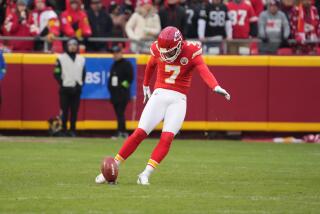In World Cup, penalty shootouts kick up controversy
- Share via
Reporting from Johannesburg, South Africa — Gerardo Martino slumped in his chair, shook his head sadly, then stated the obvious.
“Everyone knows it’s unfair to have games decided by a penalty shootout,” Paraguay’s coach said after his team’s second-round World Cup match with Japan. “But that’s the way it is.”
And Martino’s team won. So imagine how the Japanese coach felt. Takeshi Okada and his players dedicated years to get to the World Cup, only to be eliminated in soccer’s equivalent of a free-throw-shooting contest.
No wonder Okada quit moments after the game.
“Every coach would like to see a match decided in 90 minutes,” said Germany’s Joachim Loew. “Because I don’t think there’s any way you can prepare for penalty kicks.”
Yet that’s exactly how Sunday’s World Cup final between Spain and the Netherlands may end. Penalty kicks have determined two of the last four World Cup champions, and they were used to eliminate two of the final 16 teams in this summer’s tournament.
But that doesn’t make it right. Or even just – as when Ghana’s coach, Milovan Rajevac, called his team’s quarterfinal loss to Uruguay on penalty kicks “football injustice.”
Brazilian goalie Claudio Taffarel also recognized this after his team beat Italy on penalties in the 1994 World Cup final, the first to be decided in a shootout. “Penalty kicks,” he said, “don’t necessarily mean the best team came out on top.”
Which is why a Facebook group is now advocating for penalty kicks to be removed as an “utterly unfair and unjustifiable … erratic option of play.”
Soccer, after all, is a sport in which the clock never stops and the players and the ball are in constant motion. Yet if two teams remain tied after 90 minutes of regulation time and 30 minutes of extra time, all that becomes irrelevant.
Then the ball is placed, immobile, 12 yards from the goal, and everyone but the striker and the keeper do nothing but stand around and watch.
In a penalty shootout, each team gets five chances, with the sides alternating kicks in an order determined by a coin flip. If one team builds an insurmountable lead – by making its first three kicks while its opponent misses all three, for example – the game ends there. If both teams are tied after five rounds, the shootout continues into sudden death.
What that means is that teams well-versed in other skills -- such as Spain, which excels at ball-handling and passing -- are stripped of their strengths.
Yet penalty kicks are fairer than the system they replaced: Before FIFA adopted the penalty-kick format in 1970, in major tournaments in which a complete replay was not possible, ties were often broken by drawing lots. Italy advanced to the 1968 European Championship when it beat the Soviet Union in the semifinals by drawing lots. And Israel lost an Olympic quarterfinal that same year in the same way.
After that second match, the story goes, Israeli officials proposed that FIFA adopt a penalty-kick format similar to those used in domestic tournaments in Europe and South America beginning as early as 1952.
FIFA agreed, and the penalty shootout made its World Cup debut during African qualifying in 1977, when Tunisia beat Morocco. The first shootout in the championship tournament came five years later when West Germany bested France in the semifinals, and it was used to decide the champion in 1994, when Brazil beat Italy, and 2006, when Italy beat France.
Along the way some teams have learned to excel at penalty kicks. For example, Germany, which plays Uruguay in the third-place game Saturday in Port Elizabeth, has not lost a shootout in a major competition in 34 years. In fact, no German player has missed a single shot in that time.
England, on the other hand, has lost six of seven matches that were decided on penalties.
Still, Loew insists it’s not a skill you can master.
“It is not something you can replicate on a training field. There is so much pressure and burden. You have a situation where a player will possibly have to kick in the most important penalty of his life. How can you copy that?” he said.
And some of the sport’s greatest players -- from Diego Maradona, David Beckman, Cristiano Ronaldo and Roberto Baggio -- have all missed penalty kicks in major championships.
Glenn Hoddle, whose 1998 English World Cup team lost in a shootout to Argentina, said most penalty kicks are missed in the long walk from midfield to the ball. “Nine times out of 10 you can tell if a player’s going to miss it with how he reacts, what his eyes are doing, when he gets the ball on the spot,” Hoddle told journalist David Gendelman.
But there are strategies for increasing your chances for success.
One prominent manager told his players to forget about aiming and simply kick the ball as hard as they could, believing that if they had no idea where it was going, neither did the goalkeeper. A recent academic study came to the opposite conclusion, finding that a ball aimed straight down the middle had the best chance of success because the goalie has to commit to diving one way or the other.
For the keeper, meanwhile, it often comes down to study. Germany beat Argentina in a 2006 quarterfinal after goalie Jens Lehmann repeatedly referred to a cheat sheet pulled out of his sock that listed the tendencies of Argentina’s strikers.
Finally, there’s the strategy of Spanish Coach Vicente Del Bosque, which is actually no strategy at all. His players don’t practice it
“I guess the players will decide themselves, and those who are the usual suspects will be shooting the penalties,’ he said with a shrug. “They will not be under the directive of the coach.”
More to Read
Go beyond the scoreboard
Get the latest on L.A.'s teams in the daily Sports Report newsletter.
You may occasionally receive promotional content from the Los Angeles Times.







